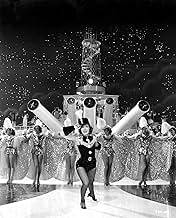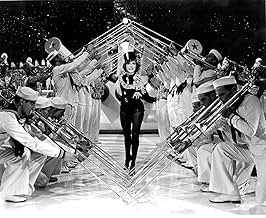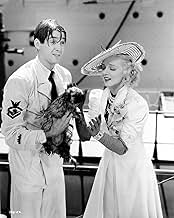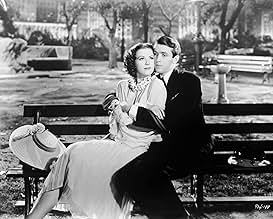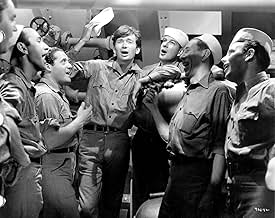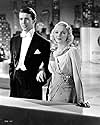Ajouter une intrigue dans votre langueOn leave, a sailor falls in love with a young lady aspiring to become a Broadway dancer, but their relationship is jeopardized by an established Broadway star, who is also enamored by him.On leave, a sailor falls in love with a young lady aspiring to become a Broadway dancer, but their relationship is jeopardized by an established Broadway star, who is also enamored by him.On leave, a sailor falls in love with a young lady aspiring to become a Broadway dancer, but their relationship is jeopardized by an established Broadway star, who is also enamored by him.
- Réalisation
- Scénario
- Casting principal
- Nommé pour 2 Oscars
- 1 victoire et 2 nominations au total
- Georges and Jalna
- (as Georges and Jalna)
- Georges and Jalna
- (as Georges and Jalna)
- Member of The Foursome
- (as Ray Johnson)
Avis à la une
And of course Cole Porter's score. It contains two of his most beloved standards, Easy to Love and I've Got You Under My Skin. The rest of the score is serviceable for the plot. I particularly like Hey Babe Hey in which all the principals of the plot participate. How they got James Stewart to dance must have been a challenge.
Of course Born to Dance is famous for Easy to Love being introduced by James Stewart. Stewart had always maintained that the proof of Easy to Love being a great song is that it survived his singing of it to become a great popular standard. His singing is adequate, but for the life of me, I'll never understand why Allan Jones who was up for the part wasn't picked. Especially since I've heard Allan Jones's contemporary recording of Easy to Love. Stewart is all right, but the part isn't exactly a stretch for his thespian talents and for cryin' out loud, Jones was one of the best movie singers ever.
The other standard is introduced by Virginia Bruce, spoiled mantrap of a Broadway musical star who takes a shine to Stewart after he saves her Pekingese from drowning while Bruce is visiting his ship at the Brooklyn Navy Yard. Bruce sings I've Got You Under My Skin directly to Stewart with a come hither glance to lure him from Eleanor Powell who is her show's understudy.
Borrowing from Hit the Deck with a plot of three sailors and three civilian women, Born to Dance pairs off Stewart with Powell, Buddy Ebsen with Frances Langford, and Sid Silvers with Una Merkel. Raymond Walburn is at his avuncular best as the ship's captain who keeps entrusting Silvers and Ebsen to deliver a message to the Admiral and they keep getting sidetracked by their women.
With Powell as the understudy to Bruce and them both vying for Stewart, you can readily guess how this story will resolve itself. Eleanor dances divinely, especially in the finale number Swinging the Jinx Away which Frances Langford sings and Buddy Ebsen also dances.
With all the talent involved and a plot which is a walking cliché, but easy to take, it's easy to love Born to Dance as I do.
The second of its annual Eleanor Powell musicals, BORN TO DANCE brings back her co- stars from her initial MGM musical, Broadway MELODY OF 1936, including Sid Silvers, Una Merkel, Frances Langford and Buddy Ebsen, with Virginia Bruce substituting for June Knight as the temperamental actress. As an added plus Frances Langford, who, in Broadway MELODY of 1936, only participated in the song numbers, this time gets to belt out her songs and take part of the plot.
Following the opening titles with a background of musical notes (yes, this is a musical) and still silhouette dancing images of Eleanor Powell, the story opens with singing sailors submerging from a submarine and going on shore leave in New York City. Ted Parker (James Stewart) meets Nora Paige (Eleanor Powell) at a Lonely Hearts Club, managed by Jenny Saks (Una Merkel), who is married to a Ted's fellow Navy partner, "Gunny" (Sid Silvers), whom she hasn't seen in four years, and through him, is the mother of a three-year-old daughter (Juanita Quigley). While Jenny finds Gunny to be a big disappointment to her, and unwilling to tell him that he is a father, Ted finds himself becoming very much interested in Nora, whose ambition is to become a dancer (hense the title). Their romance is soon broken up when Lucy James (Virginia Bruce), a famous musical-comedy star, along with her press agent, James McKay (Alan Dinehart), visits Ted's ship for publicity pictures, and after her Pekinese dog falls over board with Ted jumping in to save it, McKay then makes a romance story out of it. Ted finds his time being occupied being with Lucy, and away from Nora. However, Ted arranges for Nora to get into Lucy's upcoming show as her understudy without either girl being aware as to whom was responsible for this arrangement. As Ted is going through his complications such as believing Nora to be a mother to Jenny's little girl, there is "Mush" Tracy (Buddy Ebsen) who finds time in becoming the romantic interest of another Lonely Hearts Club employee, "Peppy" Turner (Frances Langford).
Song numbers include: "Rolling Home" (sung by the Foursome Quartet, Sid Silvers, Buddy Ebsen and James Stewart); "Rap-Tap on Wood" (sung and danced by Eleanor Powell); "Hey Babe, Hey Babe" (sung by James Stewart, Eleanor Powell, Sid Silvers, Una Merkel, Buddy Ebsen and Frances Langford); "Here Comes Lucy James" (sung by sailors); "The Captain Had a Very Bad Night Last Night" (recited by Raymond Walburn); "Love Me, Love My Pekinese" (sung by Virginia Bruce/ chorus); "Easy to Love" (sung by James Stewart & Eleanor Powell); "I've Got You Under My Skin" (danced by George & Jalna/ sung by Virginia Bruce); "Easy to Love" (sung by Frances Langford/ danced by Buddy Ebsen); "Love Me, Love My Pekinese" (audition dance by Eleanor Powell); "Swinging the Jinx Away" (sung by Frances Langford/ with Buddy Ebsen/ danced by Eleanor Powell); and "Easy to Love" (sung by cast).
The other members of the cast consists of Raymond Walburn, Barnett Parker, Jonathan Hale and Reginald Gardiner, making his movie debut, in an awkward but amusing cameo as a policeman in Central Park who fantasizes himself as conducting to the score to "Easy to Love" with an unseen orchestra (only in New York!).
As with Powell's other "Broadway Melody" series, BORN TO DANCE includes moments of singing and dancing on cue, with a full orchestra playing in the background, whether it be at the Lonely Hearts Club, on the Navy vessel or in the middle of Central Park. Comedy also takes its toll in BORN TO DANCE, including Walburn as the confusing captain who can't distinguish the difference between the very tall Mush (Ebsen) and the ultra short Gunny (Silvers), asking them if they are twins, and in giving an assignment for Mush deliver an important message to a Rear Admiral Stubbins at the Brooklyn Navy Yard. Mush, however, keeps forgetting, and when he does remember, can't find Brooklyn and ends up in Yonkers; as well as Helen Troy's classic bit as sharp-tongue Brooklyn-ese switchboard operator. Troy must have been an inspiration for Lily Tomlin's comedic character in later years when appearing as a telephone operator in the late 1960s variety comedy show of LAUGH-IN.
BORN TO DANCE is light on plot, memorable on songs and well constructed with dance numbers as choreographed by Dave Gould, highlighted by the lavish but classic 13 minute finale of "Swingin' the Jinx Away" (portions would be reused again for the finale in Eleanor Powell's latter 1943 musical titled I DOOD IT, newly re-scored to appeal more to the big band era for the time of its release).
Other than having its presentations on commercial television some decades ago, the original soundtrack recording to BORN TO DANCE was displayed in record stores in the late 1970s. If there is any Eleanor Powell worth seeing, it's BORN TO DANCE, by all means, that's what she was, and does it well. Available viewing on Turner Classic Movies. (***1/2)
As musicals go, this is in the revue tradition, with the lightest of plots tying together a collection of song and dance numbers, comic bits and of course, a big, show-stopping finale. The plot here, mixing sailors and Broadway shows only occasionally flirts with reality. The score, written for the film, is entirely by Cole Porter and includes two of his best-known standards, "Easy To Love", and "I've Got You Under My Skin". Though fun, most of the other numbers are in service of the film and were not written to become popular without it. Composers rarely threw a whole group of top songs into a musical, though Porter himself did late in his career with "Kiss Me Kate".
The songs do all serve their purpose. The opening number, "Rolling Along", introduces all the sailors with a male chorus singing something similar to a college fight song (Porter had famously written Yale's). Powell is introduced quickly after this with an orchestra playing "Easy to Love" as she walks down the street, establishing it as the film's love theme. It will be repeated in a big number in Central Park sung by Stewart and Powell. Powell is dubbed by Marjorie Lane, but Stewart is not. His voice is a bit like Fred Astaire's: a light tenor with an almost wispy feeling at times, singing in a way that is somewhere between talking and really belting out a song.
"Rap, Tap on Wood" is a show-biz style number that gives Eleanor a chance to dance in a lobby where four sailors pop up and not only sing, but also play a flute and three ocarinas. "Hey Babe Hey" with a carousel-like melody, gives all three couples a chance to sing in the same number. This film has not just the usual second couple (Merkel and Silvers), which traditionally is comedic but even a third couple. People here fall in love immediately and for no apparent reason, hence Frances Langford and Buddy Ebsen are a couple. Ebsen was an accomplished tap dancer, but here does some swaying moves like he's made of rubber, creating an odd visual effect..
"I've Got You Under My Skin" goes to Virginia Bruce, who plays a Broadway diva whose penthouse is done up in an all-white mix of Deco and Rococo with a gigantic mirror and a terrace with its own fountain. It's on the terrace that she sings it to Stewart, hoping to win him away from Powell. It's a great setting for a great song. The gigantic finale takes place on a stage version of a battleship with everyone done up in white tails and sequins and the music of "Swingin' the Jinx Away" a razzmatazz, Irving Berlin-style number with jivey sections that mention Cab Calloway as their inspiration. This gives everyone a chance to do their specialty and ends things fittingly with only the shortest of scenes afterward to tie up the ends of the plot.
Within all this director Roy Del Ruth places three extended bits by character actors, all of which are memorable. Barnett Parker was a stuffy butler with few lines in many films, but here he does a funny turn as a model home salesman-interior designer in a pompous British manner. Another Brit, Reginald Gardiner, comes on as a cop in what would usually be a ten second walk-on to interrupt the main characters (think "Singing In the Rain") but instead ends up doing a hilarious impersonation of Leopold Stokowski ("Fantasia") conducting. This bit, his first in films, made him a regular character actor in Hollywood. He's now probably best known for "Christmas In Connecticut". Ruth Troy, popular radio comedian, does a shorter but funny bit as a secretary on the phone with a friend.
Overall the film is pleasant if awfully light. The lightness actually helps as there's no need to develop any plot complexities and doesn't overdo it with too many gargantuan numbers. Some of the lines of banter in the script are genuinely funny. Mostly it's Eleanor Powell just bursting into stardom as one of the screen's best dancers ever. She also has a winning way with her character. She's warm and friendly and much like a girl next door, but also can project sophistication and social grace. Una Merkel is her usual loveable, down to earth character as the lead's friend. Stewart was himself just breaking out and had even been given some villainous roles up to this point, but here amid all the foolishness seems genuinely in love with Powell. A good, if not great musical with two great Cole Porter classics.
Le saviez-vous
- AnecdotesCole Porter picked James Stewart for the male lead and later said he sang "Easy to Love" as well as any professional singer. A dubbing track was prepared with baritone Jack Owens, but it was decided that Stewart's tenor voice was perfect for the song. In Il était une fois Hollywood (1974), Stewart said, "The song had become a huge hit, even my singing wouldn't hurt it."
- GaffesThe opening scene is set aboard a submarine entering New York Harbor while submerged at periscope depth. Her skipper would have brought her in while surfaced - the risk of collision in a busy port is substantial.
- Citations
McKay's Telephone Operator: [on phone with her friend] Oh say guess who I seen at Club Continental last night? Lucy James with that sailor she met through a Pekingese. Believe me he's a sea-goin' thrill if I ever seen one. What's he like? Well, tall - sort of the answer to a maiden's prayer on stilts. Honest he must be six feet four and that's just two inches shorter than a totem pole. Oh but he's got a smile like concentrated vodka. Vodka! Oh it's a Japanese drink made out of panther blood I think.
- Crédits fousOpening credits are shown over a female figure tap-dancing on stage.
- ConnexionsEdited into Grand Central Murder (1942)
- Bandes originalesRolling Home
(1936) (uncredited)
Music and Lyrics by Cole Porter
Sung by The Foursome, Sid Silvers, Buddy Ebsen, James Stewart and chorus
Meilleurs choix
- How long is Born to Dance?Alimenté par Alexa
Détails
Box-office
- Montant brut mondial
- 941 774 $US
- Durée1 heure 46 minutes
- Couleur
- Rapport de forme
- 1.37 : 1
Contribuer à cette page



